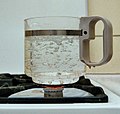Heat transfer
Heat transfer is the process by which thermal energy is exchanged between physical systems, depending on the temperature and properties of the materials involved. The fundamental modes of heat transfer are conduction, convection, and radiation. Understanding these mechanisms is essential in a wide range of disciplines, from engineering and environmental science to medicine and meteorology.
Conduction[edit]
Conduction is the transfer of heat through a solid material from a region of higher temperature to a region of lower temperature without any movement of the material as a whole. It occurs at the molecular level through the collision of particles and the movement of electrons within the body. The rate of heat transfer by conduction is governed by Fourier's law and is proportional to the temperature gradient and the cross-sectional area through which heat is conducted, and inversely proportional to the distance between the regions. Materials with high thermal conductivity, such as metals, are good conductors of heat, while those with low thermal conductivity, such as wood or foam, are considered insulators.
Convection[edit]
Convection is the transfer of heat by the physical movement of a fluid (liquid or gas) from one place to another. It can be natural, driven by buoyancy forces that result from temperature differences within the fluid, or forced, where the fluid is moved by external means such as a pump or fan. The rate of convective heat transfer is influenced by the fluid's velocity, its thermal properties, the surface area of the body being heated or cooled, and the temperature difference between the body and the fluid.
Radiation[edit]
Radiation is the transfer of heat in the form of electromagnetic waves, primarily in the infrared spectrum. Unlike conduction and convection, radiation does not require a medium and can occur in a vacuum. All bodies emit thermal radiation, and the amount of radiation emitted increases with the fourth power of the body's absolute temperature, as described by the Stefan-Boltzmann law. Factors that affect the rate of radiative heat transfer include the surface properties (emissivity and absorptivity) of the bodies involved and their relative positions and temperatures.
Applications and Implications[edit]
Heat transfer plays a crucial role in a myriad of applications. In engineering, it is fundamental to the design of heat exchangers, refrigeration and air conditioning systems, and thermal power plants. In environmental science, understanding heat transfer is essential for modeling climate change and the thermal behavior of natural systems. In medicine, heat transfer principles are applied in treatments such as hyperthermia therapy for cancer and in understanding the human body's response to extreme temperatures.
Mathematical Modeling[edit]
The mathematical modeling of heat transfer uses partial differential equations to describe the flow of heat in materials. Solutions to these equations can be complex and often require numerical methods for their solution, especially in systems with irregular geometries and varying boundary conditions.
See Also[edit]
Heat_transfer[edit]
-
Convection snapshot
-
Erbe
-
Heat transmittance means
-
Hot metalwork
-
Lightning in Arlington
-
Kochendes wasser
-
Melting icecubes
-
Nelson Tulsa test
-
Heat engine
-
Biochar
-
The green house effect
-
Air cooler
Ad. Transform your life with W8MD's Budget GLP-1 injections from $75


W8MD offers a medical weight loss program to lose weight in Philadelphia. Our physician-supervised medical weight loss provides:
- Weight loss injections in NYC (generic and brand names):
- Zepbound / Mounjaro, Wegovy / Ozempic, Saxenda
- Most insurances accepted or discounted self-pay rates. We will obtain insurance prior authorizations if needed.
- Generic GLP1 weight loss injections from $75 for the starting dose.
- Also offer prescription weight loss medications including Phentermine, Qsymia, Diethylpropion, Contrave etc.
NYC weight loss doctor appointmentsNYC weight loss doctor appointments
Start your NYC weight loss journey today at our NYC medical weight loss and Philadelphia medical weight loss clinics.
- Call 718-946-5500 to lose weight in NYC or for medical weight loss in Philadelphia 215-676-2334.
- Tags:NYC medical weight loss, Philadelphia lose weight Zepbound NYC, Budget GLP1 weight loss injections, Wegovy Philadelphia, Wegovy NYC, Philadelphia medical weight loss, Brookly weight loss and Wegovy NYC
|
WikiMD's Wellness Encyclopedia |
| Let Food Be Thy Medicine Medicine Thy Food - Hippocrates |
Medical Disclaimer: WikiMD is not a substitute for professional medical advice. The information on WikiMD is provided as an information resource only, may be incorrect, outdated or misleading, and is not to be used or relied on for any diagnostic or treatment purposes. Please consult your health care provider before making any healthcare decisions or for guidance about a specific medical condition. WikiMD expressly disclaims responsibility, and shall have no liability, for any damages, loss, injury, or liability whatsoever suffered as a result of your reliance on the information contained in this site. By visiting this site you agree to the foregoing terms and conditions, which may from time to time be changed or supplemented by WikiMD. If you do not agree to the foregoing terms and conditions, you should not enter or use this site. See full disclaimer.
Credits:Most images are courtesy of Wikimedia commons, and templates, categories Wikipedia, licensed under CC BY SA or similar.
Translate this page: - East Asian
中文,
日本,
한국어,
South Asian
हिन्दी,
தமிழ்,
తెలుగు,
Urdu,
ಕನ್ನಡ,
Southeast Asian
Indonesian,
Vietnamese,
Thai,
မြန်မာဘာသာ,
বাংলা
European
español,
Deutsch,
français,
Greek,
português do Brasil,
polski,
română,
русский,
Nederlands,
norsk,
svenska,
suomi,
Italian
Middle Eastern & African
عربى,
Turkish,
Persian,
Hebrew,
Afrikaans,
isiZulu,
Kiswahili,
Other
Bulgarian,
Hungarian,
Czech,
Swedish,
മലയാളം,
मराठी,
ਪੰਜਾਬੀ,
ગુજરાતી,
Portuguese,
Ukrainian











